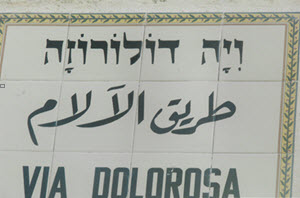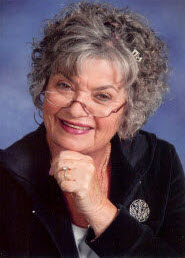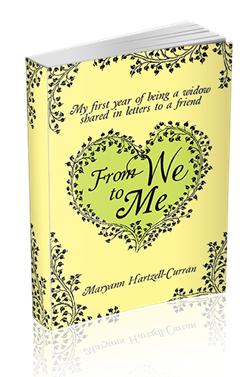The bus dropped us off at the bottom of a small hill. The guide bragged that our walk was minimal because our driver had come close to our first stop on tour. My husband and I climbed many steps arriving on a worn path obviously traveled by many. Occasionally, we each looked up trying to judge distance to our destination. We finally arrived, breathless but not enough to miss the pungency that filled the air. Scents of roses were all around us. We had arrived at the Garden of Gethsemane.
 Being Christians all of our lives, we both felt like we had come home. Though not allowed to actually walk in the Garden, our group slowly strolled around the Iron fence that surrounded this sacred place. A huge olive tree, its roots above ground, towered over, protecting us from intense morning sun. A large rock appeared to kiss these roots making me feel weak in my knees. I could picture Jesus kneeling, praying, and weeping, spending his last night here on earth.
Being Christians all of our lives, we both felt like we had come home. Though not allowed to actually walk in the Garden, our group slowly strolled around the Iron fence that surrounded this sacred place. A huge olive tree, its roots above ground, towered over, protecting us from intense morning sun. A large rock appeared to kiss these roots making me feel weak in my knees. I could picture Jesus kneeling, praying, and weeping, spending his last night here on earth.
Looking back on these precious moments, I will always remember the joy and thankfulness that my husband and I shared. Usually fast walkers, we took our time drinking in the beauty, tranquility and the fragrance of the roses in the garden. Standing at the back of the garden, we looked across a busy street to see the gates of Jerusalem. Like arms, they beckoned us to cross over experiencing more of Jesus’ sacred steps. And we did.
 Jerusalem is divided into the New and the Old. Upon arrival, we could hear a low moaning sound leading us to a large, open plaza. Looking to the right, we saw the actual Wailing Wall… a place we had only read about in books. Women crowded on the right, men on the left. Looking like a large cement slab, the only unusual markings were thousands of pieces of paper stuffed into crevices, containing prayers written by visitors. Lines of women—lines of men patiently waited their turns to touch the wall. I attempted to also, but was interrupted by many young schoolgirls giddily pushing their way forward. Satisfied to observe, I mentally took a picture.
Jerusalem is divided into the New and the Old. Upon arrival, we could hear a low moaning sound leading us to a large, open plaza. Looking to the right, we saw the actual Wailing Wall… a place we had only read about in books. Women crowded on the right, men on the left. Looking like a large cement slab, the only unusual markings were thousands of pieces of paper stuffed into crevices, containing prayers written by visitors. Lines of women—lines of men patiently waited their turns to touch the wall. I attempted to also, but was interrupted by many young schoolgirls giddily pushing their way forward. Satisfied to observe, I mentally took a picture.
Next, we walked up and down a hilly path that led us through crowded bedecked souks selling colorful jewelry, essential household items, and even suitcases. Our guide led us to the fifth station, an intersection part of the Via Delarosa where Jesus had stumbled carrying his cross. We trudged up hilly steps, down cracked curbs and continued our journey to the hill of the crucifixion. Three special monuments mark where He fell carrying his burden. Many of us crossed ourselves, somberly imagining the pain of Jesus.
The “hill” is now a mock version of what was two thousand years ago. We could hear sobs, exclamations of emotion, even seeing a man prostrate on the ground. After experiencing the Wailing Wall, moments before, my heart was heavy. Continuing on, our group walked perhaps one block, coming upon the “Tomb location” that housed our Lord’s body for three days. My legs again felt shaky, so I sought out one of the few resting benches and sat down.
We continued walking, almost weary not from distance, but walking this walk. Our bus was a haven for rest as we climbed aboard. Tired and thirsty but alive with the story, we drank bottled water, listening to our guide’s description of our next stops. Lunch was promised at a Kibbutz followed by an afternoon in Bethlehem, a mere six miles away.
Another guide for our trip through Bethlehem replaced our guide. Stopping at a monastery outside the city wall, our guide stepped off the bus as the other climbed on. Continuing our drive into the city, our first stop was the Church of the Nativity. Judging from the crowds by the main door, we knew the line would be long—the wait even longer. Everyone was there to see a place marked by a star acknowledging where the manger had stood many years ago –the place of the first Christmas.
Huge brass doors were opened, each decorated with carvings of the wise men. Large crowds patiently waited, bulging with groups of ten or more people. Security personnel herded old people, young adults, and small children. Several elderly priests draped in black garb preached, quoting scripture. On the right side of a huge room, were dozens of candles burning like infernos, inviting people to light them with long wicker sticks. The heat emanated from them, creating a glow that felt hotter as the crowd thickened. After one and half hours, my husband and I left, spending the remainder of our time in the cool, new narthex of the church.
I walked out into a beautiful courtyard. Very few people were visible enabling me to take time to enjoy the lovely roses. A huge purple blossom almost spoke to me. I had never seen a purple rose. The fragrance almost knocked me off my feet. Various statues filled spaces in the garden with inviting benches for visitors to rest upon. Calling out to my husband, he joined me, enjoying this place just discovered. We decided it was far better than the hot crowded rooms inside the church.
Later, at the time required to meet the guide, we heard stories from people who had waited to go down basement like steps to see the manger place. Next to actually being there, these stories satisfied our curiosity. It was wonderful to listen, sharing the joy of those in our group.
A drive around the remainder of the city highlighted the new Bethlehem. Spreading behind new buildings, were vast lush fields that long ago heralded the angels guiding all to the Christ child. I felt like we were experiencing the night He was born in the stable-like cave.
Our bus took us back to the main gates, dropping off our guide and retrieving our original one. We then continued on to Nazareth, only driving through its busy streets. Shops, large and small offered wares of basic housekeeping items—also jewelry and traditional clothing. Not an attractive city, it didn’t invite us to stop. In fact, we suspected potential crime problems and difficulties. We were told that a heavy population of Muslims congregated in Nazareth. Not too much was told to our group by our Jewish guide.
Cana, the city that witnessed Christ’s first miracle was the next site on the tour. Again, not an attractive place, things were hurriedly described to us with no invitation to leave the bus. As we left the city limits, we went by a huge sign featuring an advertisement selling, “Cana Wine.” We wondered what made this wine different—perhaps the miracles happening in the city colored by its name. Returning to the ship, we rested with dreams of this true “Holy Land.”
The next day, our tour left very early. As the bus crawled through rush hour traffic, we wondered what sights we would experience. Our first stop scheduled was a Kibbutz inhabited by about 1000 people. Modern Kibbutz now manufactures or harvest a specific product sold internationally. This particular one created many items made from olive oil, olive wood and green olives to eat. We did not stop, but drove past machinery and thousands of trees wrapped in a cocoon of white cloth catching ripe olives falling from branches.
We drove through green, sparkling hills laden with olive trees, grazing livestock and modern roads. Winding up the hills, we arrived at a peak, or precipice that overlooked valleys below. We were standing on the Golan Heights looking down on the Sea of Galilee. Quite large, the sea brought mental visions of Jesus walking on water quieting his frightened disciples. A whispering breeze blew my hair as we stood there. Another unbelievable part of the story was replaying in my head. Now instead of simple boats built during Jesus’ time, new water vehicles maneuver with speed on the seas of Galilee. Quite a different purpose than long ago.
 The old city of Capernaum, Mary’s birthplace, was the next stop. Leaving the bus, we walked down a dusty path that arrived at old gates made of clay. Entering, we saw an array of crumbled buildings with assorted guides standing in front to describe each place. All of the houses surrounded an old church. The church being the center of the city proved its importance as the central part of city life. Off to the right, down a long road, stood the sea, easily accessible for the fishermen long ago, residents of Mary’s birthplace. A lone flag, the flag of Israel blew straight out in the strong morning wind marking importance to this part of the story.
The old city of Capernaum, Mary’s birthplace, was the next stop. Leaving the bus, we walked down a dusty path that arrived at old gates made of clay. Entering, we saw an array of crumbled buildings with assorted guides standing in front to describe each place. All of the houses surrounded an old church. The church being the center of the city proved its importance as the central part of city life. Off to the right, down a long road, stood the sea, easily accessible for the fishermen long ago, residents of Mary’s birthplace. A lone flag, the flag of Israel blew straight out in the strong morning wind marking importance to this part of the story.
Leaving this beautiful place, we returned to the bus creeping carefully down the steep highway with only one single lane of travel. Again, the beauty of Israel abounded, and we talked very little because there were few words to describe these sights. Our destination was the River Jordan. I found it almost impossible to think I could absorb much more.
Again, many buses and people were there experiencing one of the miracles of our faith. For fifteen dollars, one could buy a gauze gown in order to participate in a baptism. Complete with a photographer who captured this moment, plaques witnessing to people whose lives had changed here were rampant. Large murals of groups and individuals being lowered into the sacred water were all around.
These murals were located at the entrances of a huge gift shop. Inside we saw thousands of carved pieces of the nativity. Jewelry made from precious metals and the fragrant spices used to preserve special occasions like frank incense and myrrh was available. My husband bought me a Jerusalem cross. Five points on a cross each depicting the five times Christ fell on his path to the crucifixion. I cherish this gift. After this purchase and several more, we left to stroll around the colorful gardens on our way back to the bus.
Lunch was at another Kibbutz. This one looked like a resort nestled into the hills of Israel with enough ample rooms, food, and beauty to fill another visit to this country. We made a mental promise to return someday. Full and tired we left for a final bus ride back to the ship. Again, we enjoyed the beautiful countryside. Everywhere I looked, I saw beauty. I shall never forget these last two days.
In conclusion, the days in the Holy Land are pictures imbedded on my memory. To share this with my husband was a blessing. To actually experience all of these places was a lifetime dream come true. Walking the walk will forever be a gift from God. Thank you.
 Thank you to all my followers and greetings to my new ones. Many of you were introduced to my work after reading my first book, FROM WE TO ME…letters to my friend. This was published in the fall of 2013 and has enjoyed some success. Many of those who have read the book have written encouraging comments, saying it was helpful to those who are experiencing grief.
Thank you to all my followers and greetings to my new ones. Many of you were introduced to my work after reading my first book, FROM WE TO ME…letters to my friend. This was published in the fall of 2013 and has enjoyed some success. Many of those who have read the book have written encouraging comments, saying it was helpful to those who are experiencing grief.


